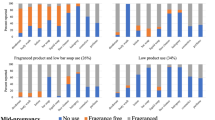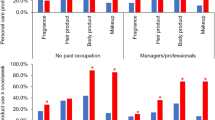Abstract
Diethyl phthalate (DEP) and di-n-butyl phthalate (DnBP) are used extensively in personal care products, including fragrances (DEP) and nail polish (DnBP). Between May 2003 and July 2006, we gathered questionnaire data on the use of seven product categories (deodorant, perfume, hair spray, hair gel, nail polish/polish remover, liquid soap/body wash, and lotion/mist) over 48 h during the third trimester of pregnancy from 186 inner-city women. A 48-h personal air sample was collected and analyzed for DEP and DnBP; a maternal spot urine sample was collected and analyzed for their monoester metabolites, monoethyl phthalate (MEP) and mono-n-butyl phthalate (MnBP), respectively. In all, 97% of air samples and 84% of urine samples were collected within ±2 days of the questionnaire. During the 48 h, 41% of women reported perfume use and 10% reported nail polish/polish remover use. In adjusted analyses, no association was seen between nail product use and air DnBP or urine MnBP concentrations. Women reporting perfume use had 2.3 times higher (95% CI 1.6, 3.3) urinary MEP concentrations. Personal air DEP increased by 7% for each 25% increase in a composite indicator of the six other product categories (P<0.05), but was not associated with perfume use. Air DEP was correlated with urine MEP concentrations only among non-perfume users (r=0.51, P<0.001). Results suggest that perfume use is a significant source of DEP exposure.
This is a preview of subscription content, access via your institution
Access options
Subscribe to this journal
Receive 6 print issues and online access
$259.00 per year
only $43.17 per issue
Buy this article
- Purchase on Springer Link
- Instant access to full article PDF
Prices may be subject to local taxes which are calculated during checkout



Similar content being viewed by others
References
Adibi J.J., Whyatt R.M., Williams P.L., Calafat A.M., Camann D., and Herrick R., et al. characterization of phthalate exposure among pregnant women assessed by repeat air, urine samples. Environ Health Perspect 2008: 116 (4): 467–473.
Anderson W.A., Castle L., Scotter M.J., Massey R.C., and Springall C.A. Biomarker approach to measuring human dietary exposure to certain phthalate diesters. Food Addit Contam 2001: 18 (12): 1068–1074.
Api A.M. Toxicological profile of diethyl phthalate: a vehicle for fragrance, cosmetic ingredients. Food Chem Toxicol 2001: 39 (2): 97–108.
Berman T., Hochner-Celnikier D., Calafat A.M., Needham L.L., Amitai Y., and Wormser U., et al. Phthalate exposure among pregnant women in Jerusalem, Israel: results of a pilot study. Environ Int 2009: 35 (2): 353–357.
Duty S.M., Ackerman R.M., Calafat A.M., and Hauser R. Personal care product use predicts urinary concentrations of some phthalate monoesters. Environ Health Perspect 2005: 113 (11): 1530–1535.
Gelman A., and Hill J. Data Analysis Using Regression Multilevel/Hierarchical Models. Cambridge University Press, Cambridge, New York, 2007.
Hauser R., Meeker J.D., Park S., Silva M.J., and Calafat A.M. Temporal variability of urinary phthalate metabolite levels in men of reproductive age. Environ Health Perspect 2004: 112 (17): 1734–1740.
Hines C.J., Nilsen Hopf N.B., Deddens J.A., Calafat A.M., Silva M.J., and Grote A.A., et al. Urinary phthalate metabolite concentrations among workers in selected industries: a pilot biomonitoring study. Ann Occup Hyg 2009: 53 (1): 1–17.
Houlihan J., Brody C., and Schwan B. “Not Too Pretty: Phthalates, Beauty Products & the FDA”. Environmental Working Group, Coming Clean, Health Care Without Harm, USA, 2002: http://www.ewg.org/files/nottoopretty_final.pdf.
Hubinger J.C., and Havery D.C. Analysis of consumer cosmetic products for phthalate esters. J Cosmet Sci 2006: 57 (2): 127–137.
Janjua N.R., Frederiksen H., Skakkebaek N.E., Wulf H.C., and Andersson A.M. Urinary excretion of phthalates and paraben after repeated whole-body topical application in humans. Int J Androl 2008: 31 (2): 118–130.
Kato K., Silva M.J., Needham L.L., and Calafat A.M. Determination of 16 phthalate metabolites in urine using automated sample preparation and on-line preconcentration/high-performance liquid chromatography/tandem mass spectrometry. Anal Chem 2005: 77 (9): 2985–2991.
Koo H.J., and Lee B.M. Estimated exposure to phthalates in cosmetics and risk assessment. J Toxicol Environ Health A 2004: 67 (23–24): 1901–1914.
Kwapniewski R., Kozaczka S., Hauser R., Silva M.J., Calafat A.M., and Duty S.M. Occupational exposure to dibutyl phthalate among manicurists. J Occup Environ Med 2008: 50 (6): 705–711.
Loretz L., Api A.M., Barraj L., Burdick J., Davis de A., and Dressler W., et al. Exposure data for personal care products: hairspray, spray perfume, liquid foundation, shampoo, body wash, and solid antiperspirant. Food Chem Toxicol 2006: 44 (12): 2008–2018.
Perera F.P., Rauh V., Tsai W.Y., Kinney P., Camann D., and Barr D., et al. Effects of transplacental exposure to environmental pollutants on birth outcomes in a multiethnic population. Environ Health Perspect 2003: 111 (2): 201–205.
Peters R.J.B. Phthalates and Artificial Musks in Perfumes. TNO Environment, Apeldoorn, The Netherlands, 2005: http://www.greenpeace.org/raw/content/international/press/reports/phthalates-and-artificial-musk.pdf.
R Development Core Team. R: A Language and Environment for Statistical Computing. 2.9.1 edn. R Foundation for Statistical Computing, Vienna, Austria, 2009.
Sathyanarayana S., Karr C.J., Lozano P., Brown E., Calafat A.M., and Liu F., et al. Baby care products: possible sources of infant phthalate exposure. Pediatrics 2008: 121 (2): e260–e268.
Schettler T. Human exposure to phthalates via consumer products. Int J Androl 2006: 29 (1): 134–139; discussion 181–135.
Shen H.Y., Jiang H.L., Mao H.L., Pan G., Zhou L., and Cao Y.F. Simultaneous determination of seven phthalates and four parabens in cosmetic products using HPLC-DAD and GC-MS methods. J Sep Sci 2007: 30 (1): 48–54.
Silva M.J., Barr D.B., Reidy J.A., Kato K., Malek N.A., and Hodge C.C., et al. Glucuronidation patterns of common urinary and serum monoester phthalate metabolites. Arch Toxicol 2003: 77 (10): 561–567.
Silva M.J., Barr D.B., Reidy J.A., Malek N.A., Hodge C.C., and Caudill S.P., et al. Urinary levels of seven phthalate metabolites in the US population from the National Health and Nutrition Examination Survey (NHANES) 1999–2000. Environ Health Perspect 2004: 112 (3): 331–338.
Steinemann A.C. Fragranced consumer products and undisclosed ingredients. Environ Impact Assess Rev 2009: 29 (1): 32–38.
Swan S.H. Environmental phthalate exposure in relation to reproductive outcomes and other health endpoints in humans. Environ Res 2008: 108 (2): 177–184.
Teass A., Biagini R., and DeBord D. Application of biological monitoring methods. In: Eller P.M. (Eds). NIOSH Manual of Analytical Method. National Institute for Occupational Safety and Health Division of Physical Sciences and Engineering, Cincinnati, OH, 1998. pp. 52–62.
Whyatt R.M., Barr D.B., Camann D.E., Kinney P.L., Barr J.R., and Andrews H.F., et al. Contemporary-use pesticides in personal air samples during pregnancy and blood samples at delivery among urban minority mothers and newborns. Environ Health Perspect 2003: 111 (5): 749–756.
Acknowledgements
The authors gratefully acknowledge the contributions of many staff and participants at the Columbia Center for Children's Environmental Health and the technical assistance of Ella Samandar, James Preau, Jack Reidy, and others at the Centers for Disease Control and Prevention (CDC) in measuring the urinary concentrations of phthalate metabolites. This work was supported by Grants R01 ES013543, R01 ES014393, and R01 ES008977 from the National Institutes of Environmental Health Sciences (NIEHS), as well as P01 ES09600/EPA RD-8321. Doctoral training support for ACJ came from T32 ES07322 and TL1 RR024158.
Author information
Authors and Affiliations
Corresponding author
Ethics declarations
Competing interests
The authors declare no conflict of interest.
Additional information
Disclaimer
The findings and conclusions in this paper are those of the authors and do not necessarily represent the views of the CDC.
Rights and permissions
About this article
Cite this article
Just, A., Adibi, J., Rundle, A. et al. Urinary and air phthalate concentrations and self-reported use of personal care products among minority pregnant women in New York city. J Expo Sci Environ Epidemiol 20, 625–633 (2010). https://doi.org/10.1038/jes.2010.13
Received:
Accepted:
Published:
Issue Date:
DOI: https://doi.org/10.1038/jes.2010.13
Keywords
This article is cited by
-
Personal care product use patterns in association with phthalate and replacement biomarkers across pregnancy
Journal of Exposure Science & Environmental Epidemiology (2024)
-
A study on the association of placental and maternal urinary phthalate metabolites
Journal of Exposure Science & Environmental Epidemiology (2023)
-
Screening for phthalates biomarkers and its potential role in infertility outcomes in Jordan
Journal of Exposure Science & Environmental Epidemiology (2023)
-
Prenatal exposure to multiple environmental chemicals and birth size
Journal of Exposure Science & Environmental Epidemiology (2023)
-
Association between urinary phthalate metabolites and chronic obstructive pulmonary disease incidence in US adults: results from NHANES 2007–2018
Environmental Science and Pollution Research (2023)



